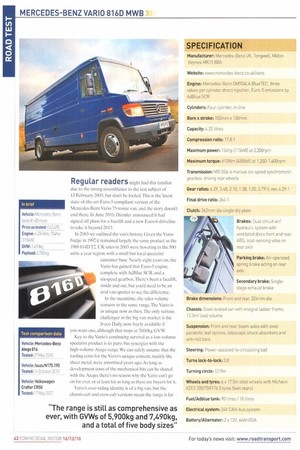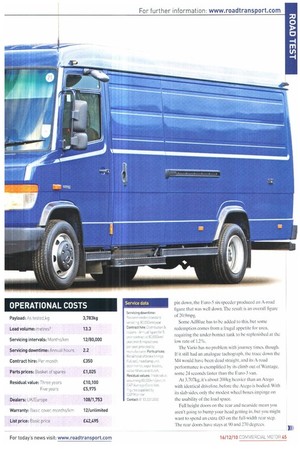Regular readers might find this familiar due to the strong
Page 42

Page 44

Page 45

Page 46

If you've noticed an error in this article please click here to report it so we can fix it.
resemblance to the test subject of 13 February 2003. but don't be fooled. This is the latest state-of-the-art Euro-5-compliant version of the Mercedes-Benz Vario 7,5-tonne van, and the story doesn't end there. In June 2010, Daimler announced it had signed off plans for a facelift and a new Euro-6 driveline to take it beyond 2013.
In 2003 we outlined the van's history. Given the Vario badge in 1997, it remained largely the same product as the 1988 814D T2. UK sales in 2003 were hovering in the 500 units a year region, with a small but loyal specialist customer base. Nearly eight years on, the Vario has gained that Euro-5 engine, complete with AdBlue SCR, and a six-speed gearbox. There's been a facelift, inside and out, but you'd need to be an avid van-spotter to see the difference. In the meantime, the sales volume remains in the same range. The Vario is as unique now as then. The only serious challenger in the big van market is the Iveco Daily, now freely available if you want one, although that stops at 7,000kg GVW Key to the Vario's continuing survival as a low-volume specialist product is its parts bin synergies with the high-volume Atego range. We can safely assume that the tooling costs for the Vario's unique content, mainly the sheet metal, were amortised years ago. As long as development costs of the mechanical bits can be shared with the Atego, there's no reason why the Vario can't go on for ever, or at least for as long as there are buyers for it.
Vario's over-riding identity is of a big van, but the chassis-cab and crew-cab versions mean the range is far wider, forming the basis for many special body conversions, as well as standard dropsidcs and tippers. Car-recovery transporters are popular and just a few weeks ago, we spotted a convoy of half dozen or so body-builder-fresh mobile aircraft steps on the Ml.
The range is as comprehensive as ever, with GVWs of 5,990kg and 7,490kg, and a total of five body sizes, ranging from 10.4m3 to 17.4m3. thanks to three wheelbases and two roof heights. Three ratings of the familiar 4.25-litre Ofv1904LA Euro-5 engine — 128hp/500Nm, 154hp/610Nm and 175hp/675Nm — normally all drive the rear wheels through a conventional six-speed manual, although automatic and 4x4 options can be ticked. Our Vario 816D test van definitely came from the middle ground, with the middle engine rating. medium wheelbase and standard roof.
On the road .orge•—•••••-•. _AAA If you were presented with this Vario when it was already ticking over, you might be tempted to walk away, as it suffers from a noticeable resonance at idle. However. once on the move, this disappears and noise levels are no longer an issue, even through the relative lack of insulation from the engine.
The Atego-derived engine is flexible with the 610Nm making itself available where needed. Gearing is well suited, running at 1,800rpm on the limit in sixth, a gear that suits cruising in most situations. The driveline layout gives rise to an unfashionably long gear lever that amplifies any play in the linkage, but fulfils its role with no issues.
The ride from the leaf suspension remains firm all the time but. for some reason, it only really loses its composure on catseyes, coping easily with much worse challenges. The steering is a little on the light side but never loses feel and guides the Vario to respectable, drama-free handling.
While it feels a bit strange to he driving a van with air brakes, they are powerful and progressive, although we weren't able to track test them.
We did establish that the park brake would easily hold the van on the test track's steepest 1-in-3 slope, and it restarted as easily. The standard engine brake is notably ineffective. with the rather more useful constant throttle brake £507 extra.
Placing the snub-nosed bonnet is easy through the big windscreen and proper truck mirrors, while the doors feature those relics from the 1970s. opening quarter lights, as well as an extra top glass panel. This still doesn't have a sun visor, although the big single-piece roller blind does a good job at the front.
Productivity In our previous Vario test, the big van with Euro-3 emissions and five forward gears had a considerable advantage over the conventional 7.5-tonne competition thanks to its smoother aerodynamics at 70mph, giving 22mpg overall.
That was definitely a test of two halves, though. as it had a 5.4mpg difference between motorway and A-road sections.
This time we were, of course, hobbled on the motorway by the speed limiter, which saw a 2mpg improvement on the Newbury to Magor run.
However, for some reason we can't pin down, the Euro-5 six-speeder produced an A-road figure that was well down. The result is an overall figure of 20.9mpg.
Some AdBlue has to be added to this, but some redemption comes from a frugal appetite for urea, requiring the under-bonnet tank to be replenished at the low rate of 1.2%.
The Vario has no problem with journey times. though. If it still had an analogue tachograph, the trace down the M4 would have been dead straight, and its A-road performance is exemplified by its climb out of Wantage, some 24 seconds faster than the Euro-3 van.
At 3.707kg, it's about 200kg heavier than an Atego with identical driveline, before the Atego is bodied. With its slab sides, only the modest wheel boxes impinge on the usability of the load space.
Full height doors on the rear and nearside mean you aren't going to hump your head getting in. hut you might want to spend an extra £83 on the full-width rear step. The rear doors have stays at 90 and 270 degrees.
Cab comfort
The Vario is quite possibly the easiest 7.5-tonner to get in and out of and, despite the removable engine cover, it's almost as easy through the passenger door as the driver's.
A slab-like fascia is now black with grey lower panels, but is otherwise totally devoid of any style. It is functional, though, and presents no serious ergonomic problems. You'd better like the steering wheel position because you're stuck with it, although it does feature an airbag these days. A decently adjustable driving seat aids getting comfortable, the most irritating part of the seating position being the uneven floor around the throttle pedal.
Seating t'or the driver and two passengers is trimmed with restrained cloth. The passenger seat folds forward hut has no modern work surface on its rear, while the whole driving seat tips forward to give access to batteries and tools. The familiar gear lever, the source of numerous smutty jokes down the years, is in easy reach, with the park brake lever behind it.
The dash features a full truck-set of instruments, including fuel, water temperature and two for air pressure. The biggest change to the panel is the digital outside temperature display, which is now combined with a bar graph indicating AdBlue contents.To the right of the fixed column are switches for electric windows, cab and loadspace lights, the engine brake linkage with foot pedal and a lighter socket. Chunky stalks control the feeble engine brake on the right, and lights and wipers on the left. Surprisingly, given the Vario's parts bin make-up, cruise control is not even an option. Electric mirror switches are on the door.
Heater controls are spread across the fascia, above the unfashionably large ashtray and storage bin on the removable engine cover. The digi-tach and radio/CD live above the windscreen, where you might expect a bit of storage. Instead, there are some thin door pockets, and a document holder and coat hook on the upholstered bulkhead.
Thanks to containing the fusebox, the glovebox is like a reverse Tardis, half as big on the inside as the outside. However, its lid does form the only table surface, easily capable of supporting a Double Whopper meal, as long as you don't go large. The only drinks storage is a large but hard-to-reach bottle holder, between the tool box and the driver's door. •
























































































































